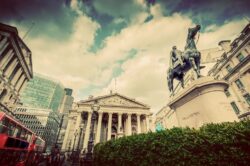Have you heard about MMT yet? Modern Monetary Theory?
It’s all the rage. And now it’s in the halls of government, as we discussed yesterday. This ideology is ruling the world.
But what is it?
Today I’ll try to give you a simple primer on MMT. So you’re informed about the debate to come.
But don’t forget that MMT is already being practiced by governments around the world anyway. You’re in time for the debate, but events have moved on…
What is Modern Monetary Theory?
According to MMT, as I understand it anyway, government debt doesn’t matter.
I know that sounds absurd, but the MMTers – I call them Fiscal Fanaticists – have got some very good points. Not to mention reality proving them right so far at least…
Under MMT, monetary policy is little more than a financing source for governments. Central banks provide a limitless credit card type bank account to politicians. The emphasis is on limitless and never needing to repay it. Interest rates and traditional monetary policy are of minimal importance to the economy. Printing money to finance government spending is what matters.
Because of this relationship between the central bank and the government, there is no limit to government spending. No constraint on the size of the deficit. The government can just print the money it needs.
Which is exactly what’s happening today, all around the world, even more openly than after the 2008 crisis. But let’s stick with the theory for now.
Central banks printing money for governments means taxes are irrelevant to funding the government. There isn’t any genuine link between government spending and taxation, nor between government borrowing and taxation. Those connections are an illusion because monetary policy can provide limitless funding.
I do realise this sounds absurd and goes against everything you were taught to believe. But stick with me for a little longer…
MMT argues government spending is the key to managing GDP, much as it was under Keynesianism, but with the monetary plumbing relayed in a way that makes the credit card limitless and thereby government spending limitless. The debt really doesn’t matter.
That’s why I call this ideology Fiscal Fanaticism. It’s all about government spending and nothing else matters (much).
But there are other constraints. Including the one you’re probably yelling at the screen as you read this – inflation.
MMT has that covered. You see, there is a certain amount of GDP which the economy is capable of without causing inflation. Think of it as the capacity of the economy. If the economy is below capacity, the government should spend until that capacity is reached, to minimise unemployment and other bad things.
If GDP is running too hot, beyond its capacity, inflation picks up because there is too much competition for resources in the economy. People bid up the price of oil, floorspace and salaries. The government should spend less (or tax more) to slow down GDP back to the capacity level.
It is this government spending, relative to capacity, which drives inflation. Inflation is not a monetary phenomenon, in other words. It is a fiscal one.
The conclusion is a government-run economy. At least in terms of the speed – inflation and GDP growth. All financed by central bank spending. However much is needed.
As far as I can tell, all of this is accurate. Self-evident, even. But why did we get it so wrong in the past? Why is MMT so new to us? And where does it all go wrong in the future, if it does?
Money is now a political tool
The key insight of MMT – the eureka moment for me when it came to understanding the ideology – is that money is a tax credit.
Let’s take a step back to explain. Money used to be something of value, like gold. But these days, money is valuable because you need it to pay your taxes.
Money is really a get-out-of-jail card. You need it to get out of jail for tax evasion.
If you accept this fundamental shift, then everything else about MMT falls into place.
Once money is under the complete control of governments, as it almost is today, they can do what they like with it. They don’t have to worry about money. It is a mere tool for controlling the economy. Debt is a measure of how much money there is and taxes are really just for controlling the direction of the economy.
I hope you can see just how radical this is. Taxes aren’t the only source of funding for the government, the central bank is, too. And without limit, enabling politicians to do whatever they want to manage the economy. Anything they like.
But that also reveals…
How this is going to go badly wrong
Historically, when governments exerted this much power over money and the economy, they overdid it. That’s just what politicians do. Without fiscal accountability, they spend so much it causes inflation, spend on misguided projects that wreak havoc on the economy, or start a war.
That’s why I think money is best kept as gold – to stop politicians from overdoing it. The next best solution, which we turned to since the 70s, is having central banks independent from government. Central banks were supposed to say “no” to politicians wanting to use the printing press to implement MMT.
But this independence is precisely what has been breached. Thanks to Covid-19, the last remaining divide between central banks and financing government spending is flattened. Central bankers around the world are now forced to print money to keep government spending alive. If they don’t, there’s a chance that governments would go bust.
We’re in the age of MMT already, whether you like it or not. Because of all that debt we began the week discussing.
And every time we’ve tried this, it has ended in a crisis. The only question is how…

Nick Hubble
Editor, Fortune & Freedom




